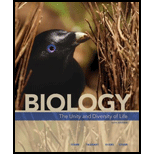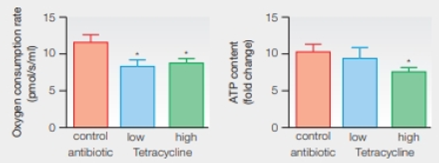
Concept explainers
Antibiotic Effects on Mitochondria Tetracyclines are antibiotics that inactivate bacterial ribosomes. Knowing that mitochondria evolved from bacteria, researchers suspected tetracyclines might affect mitochondria by harming their ribosomes. FIGURE 19. 11 shows the effects of an experiment in which mice were given either tetracycline or a control antibiotic that affects cell wall production. After 10 days of treatment, the function of mitochondria in the mice was assessed.

FIGURE 19.11 Effects of tetracycline on mitochondria. Mice received low-dose tetracycline, high-dose tetracycline, or a control antibiotic that targets bacterial cell walls. Mitochondrial function was assessed by looking at oxygen consumption rate and ATP content in homogenized mouse livers. Bar graphs show means with standard error. An * indicates a statistically significant difference between the experimental and the control treatments.
How did the two drugs differ in their effect on oxygen consumption by mitochondria?
To determine: The effects of control antibiotic and tetracycline on the oxygen consumption by mitochondria.
Concept introduction: Mitochondria are the powerhouse of the cell. It requires oxygen to produce the ATP in sufficient quantities to perform the energy-requiring reactions in eukaryotic organisms. Tetracycline is an antibiotic that works only against bacterial infections and does not work against viral infections.
Explanation of Solution
Control antibiotic, high dose and low dose of tetracycline are injected to the mice in order to check their oxygen consumption by the mitochondria. The graph shows that the control antibiotic results in higher oxygen consumption rate when compared to tetracycline. The mice that are injected with high and low dose of the tetracycline shows less oxygen consumption by the mitochondria than the control one.
Tetracycline antibiotics have an effect on the oxygen consumption rate in the mice.
Want to see more full solutions like this?
Chapter 19 Solutions
Biology: The Unity and Diversity of Life (MindTap Course List)
Additional Science Textbook Solutions
College Physics: A Strategic Approach (3rd Edition)
Genetics: From Genes to Genomes
Campbell Essential Biology (7th Edition)
Microbiology Fundamentals: A Clinical Approach
Human Physiology: An Integrated Approach (8th Edition)
- Can you described the image? Can you explain the question as well their answer and how to get to an answer to an problem like this?arrow_forwardglg 112 mid unit assignment Identifying melting processesarrow_forwardGive only the mode of inheritance consistent with all three pedigrees and only two reasons that support this, nothing more, (it shouldn't take too long)arrow_forward
- Oarrow_forwardDescribe the principle of homeostasis.arrow_forwardExplain how the hormones of the glands listed below travel around the body to target organs and tissues : Pituitary gland Hypothalamus Thyroid Parathyroid Adrenal Pineal Pancreas(islets of langerhans) Gonads (testes and ovaries) Placentaarrow_forward
- What are the functions of the hormones produced in the glands listed below: Pituitary gland Hypothalamus Thyroid Parathyroid Adrenal Pineal Pancreas(islets of langerhans) Gonads (testes and ovaries) Placentaarrow_forwardDescribe the hormones produced in the glands listed below: Pituitary gland Hypothalamus Thyroid Parathyroid Adrenal Pineal Pancreas(islets of langerhans) Gonads (testes and ovaries) Placentaarrow_forwardPlease help me calculate drug dosage from the following information: Patient weight: 35 pounds, so 15.9 kilograms (got this by dividing 35 pounds by 2.2 kilograms) Drug dose: 0.05mg/kg Drug concentration: 2mg/mLarrow_forward
- A 25-year-old woman presents to the emergency department with a 2-day history of fever, chills, severe headache, and confusion. She recently returned from a trip to sub-Saharan Africa, where she did not take malaria prophylaxis. On examination, she is febrile (39.8°C/103.6°F) and hypotensive. Laboratory studies reveal hemoglobin of 8.0 g/dL, platelet count of 50,000/μL, and evidence of hemoglobinuria. A peripheral blood smear shows ring forms and banana-shaped gametocytes. Which of the following Plasmodium species is most likely responsible for her severe symptoms? A. Plasmodium vivax B. Plasmodium ovale C. Plasmodium malariae D. Plasmodium falciparumarrow_forwardStandard Concentration (caffeine) mg/L Absorbance Reading 10 0.322 20 0.697 40 1.535 60 2.520 80 3.100arrow_forwardPlease draw in the missing answer, thank youarrow_forward
 Biology: The Dynamic Science (MindTap Course List)BiologyISBN:9781305389892Author:Peter J. Russell, Paul E. Hertz, Beverly McMillanPublisher:Cengage Learning
Biology: The Dynamic Science (MindTap Course List)BiologyISBN:9781305389892Author:Peter J. Russell, Paul E. Hertz, Beverly McMillanPublisher:Cengage Learning
 Biology 2eBiologyISBN:9781947172517Author:Matthew Douglas, Jung Choi, Mary Ann ClarkPublisher:OpenStax
Biology 2eBiologyISBN:9781947172517Author:Matthew Douglas, Jung Choi, Mary Ann ClarkPublisher:OpenStax Human Heredity: Principles and Issues (MindTap Co...BiologyISBN:9781305251052Author:Michael CummingsPublisher:Cengage Learning
Human Heredity: Principles and Issues (MindTap Co...BiologyISBN:9781305251052Author:Michael CummingsPublisher:Cengage Learning Biology Today and Tomorrow without Physiology (Mi...BiologyISBN:9781305117396Author:Cecie Starr, Christine Evers, Lisa StarrPublisher:Cengage Learning
Biology Today and Tomorrow without Physiology (Mi...BiologyISBN:9781305117396Author:Cecie Starr, Christine Evers, Lisa StarrPublisher:Cengage Learning





